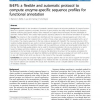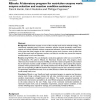NAR
2011
13 years 9 months ago
2011
The BRENDA (BRaunschweig ENzyme Database, http://www.brenda-enzymes.org) enzyme information system is the main collection of enzyme functional and property data for the scientific...
BMCBI
2010
13 years 9 months ago
2010
Background: The functional and structural characterisation of enzymes that belong to microbial metabolic pathways is very important for structure-based drug design. The main inter...
BMCBI
2010
13 years 11 months ago
2010
Background: Models for the simulation of metabolic networks require the accurate prediction of enzyme function. Based on a genomic sequence, enzymatic functions of gene products a...
NAR
2000
14 years 2 months ago
2000
LIGAND is a composite database comprising three sections: ENZYME for the information of enzyme molecules and enzymatic reactions, COMPOUND for the information of metabolites and o...
NAR
2000
14 years 2 months ago
2000
The ENZYME database is a repository of information related to the nomenclature of enzymes. In recent years it has became an indispensable resource for the development of metabolic...
BMCBI
2007
14 years 2 months ago
2007
Using a previously developed automated method for enzyme annotation, we report the reannotation of the ENZYME database and the analysis of local error rates per class. In control ...
BMCBI
2006
14 years 2 months ago
2006
Background: Restriction enzymes are one of the everyday tools used in molecular biology. The continuously expanding panel of known restriction enzymes (several thousands) renders ...
BMCBI
2008
14 years 2 months ago
2008
Background: Enzymes are responsible for the catalysis of the biochemical reactions in metabolic pathways. Analogous enzymes are able to catalyze the same reactions, but they prese...
BMCBI
2007
14 years 2 months ago
2007
Background: A metabolic network is the sum of all chemical transformations or reactions in the cell, with the metabolites being interconnected by enzyme-catalyzed reactions. Many ...
IMECS
2007
14 years 3 months ago
2007
— A pseudo-reverse approach is presented in this paper to analyze the evolutionary behaviour of enzymes. It employs the standard model of Nei and Gojobori [1] in a generalized fo...





